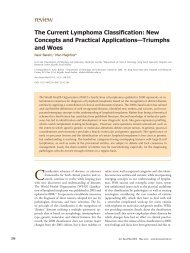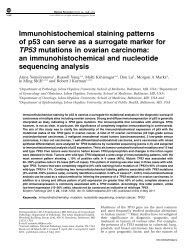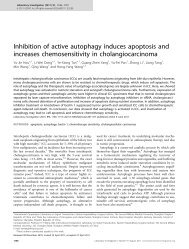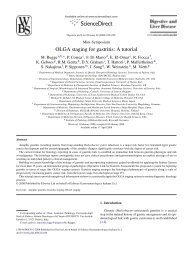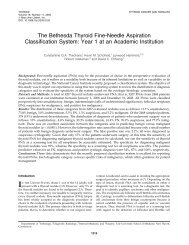Morphological subtypes of ovarian carcinoma: a ... - BPA Pathology
Morphological subtypes of ovarian carcinoma: a ... - BPA Pathology
Morphological subtypes of ovarian carcinoma: a ... - BPA Pathology
Create successful ePaper yourself
Turn your PDF publications into a flip-book with our unique Google optimized e-Paper software.
SUBTYPES OF OVARIAN CARCINOMA 425changes. TP53 mutations have been demonstrated in some p53signatures and these may represent the earliest stage <strong>of</strong> development<strong>of</strong> high grade pelvic serous <strong>carcinoma</strong>. However, p53signatures are extremely common in the fallopian tube, even inpatients with benign disease and no hereditary predisposition todeveloping <strong>ovarian</strong> cancer, and it is clear that only a smallproportion will ever develop into a serous TIC. Serous TIC isnot diagnosed on the basis <strong>of</strong> p53 staining unless associatedmorphological alterations are present associated with a highMIB1 proliferation index.It is probable that not all high grade pelvic serous <strong>carcinoma</strong>sare derived from the fallopian tube. A recent study whichsystematically examined all <strong>of</strong> the fallopian tubes in a consecutiveseries <strong>of</strong> <strong>ovarian</strong> <strong>carcinoma</strong>s identified serous TIC innearly 60% <strong>of</strong> high grade serous <strong>carcinoma</strong>s but not in othermorphological <strong>subtypes</strong> <strong>of</strong> <strong>ovarian</strong> <strong>carcinoma</strong>. 33 It is possiblethat some high grade serous <strong>carcinoma</strong>s do arise from the<strong>ovarian</strong> surface epithelium or the epithelium <strong>of</strong> corticalinclusion cysts, the latter being lined by ciliated epitheliumidentical to that lining the fallopian tube. Another possibility inthose cases in which no premalignant or malignant lesion isfound in the fallopian tube is that tubal epithelium mayexfoliate and become incorporated into the ovary and subsequentlygive rise to a high grade serous <strong>carcinoma</strong>. 33It can be summarised that there is accumulating evidence thatmany, or even most, high grade pelvic serous <strong>carcinoma</strong>s (highgrade serous <strong>carcinoma</strong>s which are currently classified as<strong>ovarian</strong>, tubal or peritoneal in origin) arise from the fimbria<strong>of</strong> the fallopian tube. In most cases, the malignant cellsexfoliate from the fimbria into the pelvis and abdomen andresult in the formation <strong>of</strong> an <strong>ovarian</strong> mass or masses usually, butnot always, with disease elsewhere in the pelvis and abdomen;this is conventionally referred to as <strong>ovarian</strong> high grade serous<strong>carcinoma</strong>. In other cases, the neoplasm remains localised tothe fallopian tube, resulting in a fallopian tube high gradeserous <strong>carcinoma</strong>, or gives rise to extensive peritoneal diseasein the absence <strong>of</strong> significant <strong>ovarian</strong> or tubal involvement; thisis conventionally referred to as primary peritoneal high gradeserous <strong>carcinoma</strong>. It is likely that neoplasms which are currentlyclassified as high grade serous <strong>carcinoma</strong>s <strong>of</strong> the ovary,fallopian tube and peritoneum are all different manifestations<strong>of</strong> the same disease and the designation high grade pelvicserous <strong>carcinoma</strong> may be more appropriate. A consequence<strong>of</strong> these observations is that screening programmes for <strong>ovarian</strong><strong>carcinoma</strong> may be relatively ineffective in downstaging highgrade serous <strong>carcinoma</strong>s since these are most likely disseminatedfrom the outset. However, screening may be <strong>of</strong> value inpicking up serous <strong>carcinoma</strong>s when the burden <strong>of</strong> disease islower and will also identify other morphological <strong>subtypes</strong> <strong>of</strong><strong>carcinoma</strong> which probably do arise within the ovary. Futurestudies investigating the underlying molecular events in thedevelopment <strong>of</strong> high grade pelvic serous <strong>carcinoma</strong> shouldconcentrate on the distal fallopian tube.MUCINOUS CARCINOMAPrimary <strong>ovarian</strong> mucinous <strong>carcinoma</strong>s affect a wide age range,including occasionally children and adolescents. As discussed,they are relatively uncommon, the two studies referred toearlier suggesting that these account for approximately 3%<strong>of</strong> primary <strong>ovarian</strong> <strong>carcinoma</strong>s, 7,8 a significantly lower percentagethan in older studies. The reasons behind the apparentmarked decline in primary <strong>ovarian</strong> mucinous <strong>carcinoma</strong>s arewell known. In older studies, it is likely that many presumedprimary <strong>ovarian</strong> mucinous <strong>carcinoma</strong>s, especially <strong>of</strong> advancedstage, were metastases from extra<strong>ovarian</strong> sites. Advances inimaging, serum markers and preoperative workup have resultedin better recognition <strong>of</strong> metastatic <strong>ovarian</strong> neoplasms with theresult that many <strong>of</strong> these are not surgically removed. Moreover,pathologists are now better at recognising the morphologicalfeatures <strong>of</strong> metastatic mucinous <strong>carcinoma</strong> in the ovary, 1,46–52including the tendency to cystic change and the well knownmaturation phenomenon resulting in areas resembling benignand borderline mucinous cystadenoma. The use <strong>of</strong> differentialcytokeratin staining and other immunohistochemical markers53–60 has also improved the situation, although problemsstill exist. It is now clear that <strong>ovarian</strong> mucinous neoplasmsassociated with pseudomyxoma peritonei are almost always <strong>of</strong>appendiceal origin, 61–63 with the very rare exception <strong>of</strong> primary<strong>ovarian</strong> mucinous neoplasms <strong>of</strong> overtly large intestinal typearising in a dermoid cyst. 64 It seems to be overtly large intestinaltype mucinous epithelium which has the potential to result inpseudomyxoma peritonei. There has also been a redefinition <strong>of</strong>the criteria for diagnosis <strong>of</strong> a well differentiated mucinous<strong>carcinoma</strong> with so-called expansile (non-destructive, confluentglandular) invasion; 1,46–52,65,66 the distinction <strong>of</strong> this from amucinous borderline tumour at the upper end <strong>of</strong> the spectrum stillrepresents a somewhat poorly reproducible area amongst pathologists,resulting in some variation in the reported prevalence<strong>of</strong> primary <strong>ovarian</strong> mucinous <strong>carcinoma</strong> between centres.Most primary <strong>ovarian</strong> mucinous <strong>carcinoma</strong>s are unilateraland stage I and advanced stage neoplasms (stage III or IV) areextremely uncommon. In this scenario, a secondary shouldalways be strongly considered. Although metastatic mucinous<strong>carcinoma</strong>s in the ovary are still sometimes misdiagnosed as aprimary <strong>ovarian</strong> mucinous <strong>carcinoma</strong> or even a mucinousborderline tumour due to the prounced maturation effect seenwith some secondary mucinous <strong>carcinoma</strong>s in the ovary, wehave to some extent come full circle in that, in my opinion,there is now a tendency to overplay the possibility <strong>of</strong> ametastasis even when the pathological features are obviouslythose <strong>of</strong> a primary <strong>ovarian</strong> neoplasm. I feel that in a largemajority <strong>of</strong> cases the distinction between a primary and secondarymucinous <strong>carcinoma</strong> in the ovary can be achieved bycareful pathological examination encompassing both the grossand microscopic findings and taking into account the distribution<strong>of</strong> the disease. It has been stated that when a mucinous<strong>carcinoma</strong> is diagnosed in the ovary, further investigations,such as colonoscopy and detailed imaging <strong>of</strong> the upperabdomen, should be undertaken to exclude a primary neoplasmelsewhere but I feel this is unnecessary. Features suggesting ametastatic mucinous <strong>carcinoma</strong> in the ovary have been extensivelydiscussed elsewhere 46–52 and are listed in Table 3.Table 3Features favouring metastasis in <strong>ovarian</strong> mucinous <strong>carcinoma</strong>Bilateral tumoursSmall tumoursNodular pattern <strong>of</strong> <strong>ovarian</strong> involvementMicroscopic surface deposits <strong>of</strong> tumourMarked lymphovascular space invasion (especially outside ovary and in hilum)Marked variation in growth pattern from one nodule to anotherDestructive stromal invasionSingle cell infiltration and signet ring cellsCells ‘floating’ in mucinExtra<strong>ovarian</strong> spreadNone <strong>of</strong> these features are pathognomonic but are <strong>of</strong>ten seen in combination.Copyright © Royal College <strong>of</strong> pathologists <strong>of</strong> Australasia. Unauthorized reproduction <strong>of</strong> this article is prohibited.




